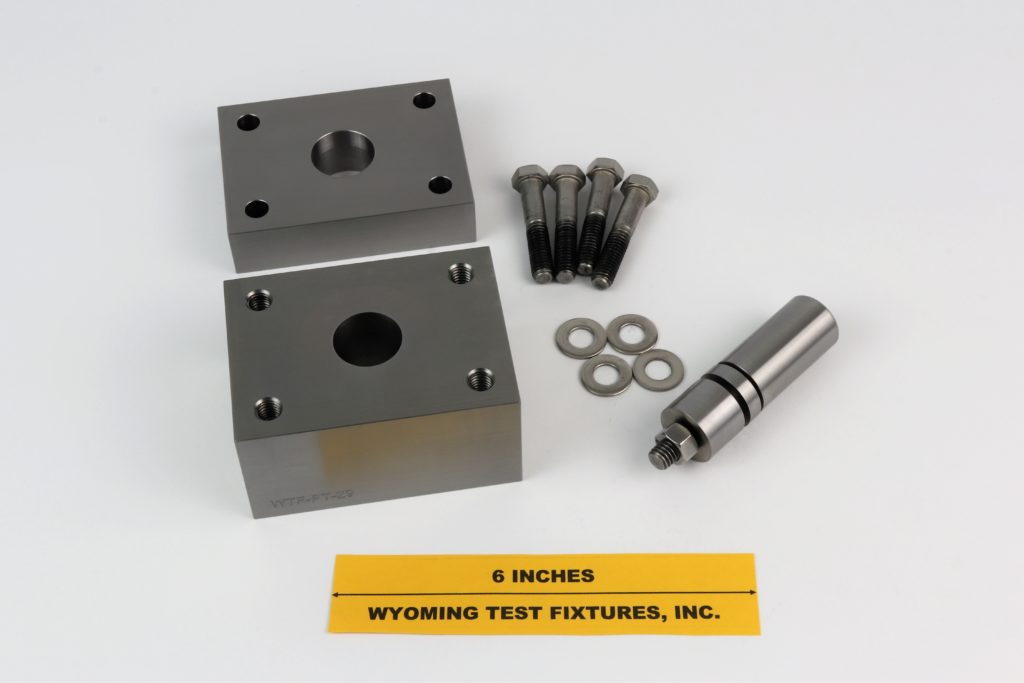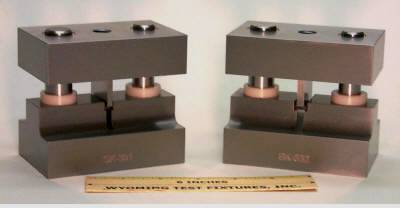Shear Strength of Plastics by Punch Tool (ASTM D732)
Model No. WTF-PT (Stainless Steel)

Fig. 1: Disassembled ASTM D732 Punch Shear Test Fixture.
ASTM D732, first published in 1943 (Reference 1), defines a punch-type of shear test. It is intended for use as a materials screening and materials comparison test of plastics available in the form of sheets or molded disks. Specimen thicknesses can range from 0.050 in. to 0.500 in.. A 1 in. diameter disk is punched out of the test specimen using the test fixture shown in Fig. 1.
The specimen is 2 in. square or 2 in. in diameter, with a 7/16 in. diameter hole drilled in the center. This specimen is clamped between the two hardened steel disks of the punch shown at the lower right of the photograph. The lower end of the punch is then placed in the hole in the base plate (lower left) and the cover plate (top) is bolted on to hold the specimen securely in place. With the fixture resting on the base of the testing machine, a compressive force is applied to the top of the punch to shear out a 1 in. diameter disk from the specimen.
The shear force is simply calculated as the maximum force applied divided by the shear area (punch circumference x specimen thickness).
This test method is intended as a comparative test, and not as a quantitative measure of the shear strength of the material. As a materials screening test it does have the advantages of requiring a simple specimen and utilizing a simple test procedure. However, a uniform shear stress state is not attained; severe stress concentrations occur at the edges of the punch. If design values of shear strength are desired, either the Iosipescu Shear (Reference 2) or V-Notched Rail Shear (Reference 3) test method is recommended.
Other non-standard, comparative-type punch shear test methods have also been developed. The following photograph shows two such fixtures. In both fixtures shown, a specimen in the form of a bar of rectangular cross section is simply placed in a slot in the base and a flat-bottomed guillotine is pressed against the bar, shearing it into three pieces.

Fig. 2: Alternate Punch Shear Fixture Configurations.
Sources of Additional Information:
1) ASTM Standard D732-10 (2010), "Standard Test Method for Shear Strength of Plastics by Punch Tool", American Society for Testing and Materials, West Conshohocken, Pennsylvania (first published in 1943).
2) ASTM Standard D5379-12 (2012), "Standard Test Method for Shear Properties of Composite Materials by the V-Notched Beam Method", American Society for Testing and Materials, West Conshohocken, Pennsylvania (first published in May 1993).
3) ASTM Standard D7078-12 (2012), "Standard Test Method for Shear Properties of Composite Materials by the V-Notched Rail Shear Method", American Society for Testing and Materials, West Conshohocken, Pennsylvania (first published in April 2005).

